| Allen Formation | |
|---|---|
| Stratigraphic range: Mid Campanian-Maastrichtian ~ | |
 Outcrop of the Allen and Anacleto Formations at Auca Mahuida | |
| Type | Geological formation |
| Unit of | Malargüe Group |
| Underlies | Jagüel Formation |
| Overlies | Anacleto Formation |
| Thickness | up to 70 m (230 ft) |
| Lithology | |
| Primary | Mudstone, sandstone |
| Other | Limestone |
| Location | |
| Coordinates | 40°00′S66°36′W / 40.0°S 66.6°W |
| Approximate paleocoordinates | 42°48′S52°12′W / 42.8°S 52.2°W |
| Region | Neuquén, Río Negro & La Pampa Provinces |
| Country | Argentina |
| Extent | Neuquén Basin |
| Type section | |
| Named by | Uliana & Dellapé |
| Year defined | 1981 |
The Allen Formation is a geological formation in Argentina whose strata date back to the Late Cretaceous (middle Campanian to early Maastrichtian. [1] Dinosaur remains are among the fossils that have been recovered from the formation. [2] Indeterminate chelid remains and other vertebrates have also been discovered in this formation. [3]















